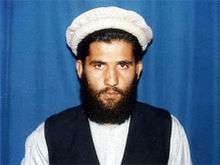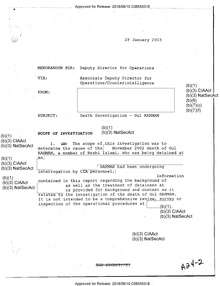Gul Rahman
Gul Rahman (Pashto: ګل رحمان; died 20 November 2002) was an Afghan man, suspected by the United States of being a militant, who was a victim of torture. He died in a secret CIA prison, or black site, located in northern Kabul, Afghanistan known as the Salt Pit.[1][2] He had been captured October 29, 2002.[3][4]
| Gul Rahman | |
|---|---|
 Photo of Gul Rahman, released by his family | |
| Arrested | October 2002 Pakistan To find Hekmatyar |
| Died | 20 November 2002 the Salt Pit |
| Citizenship | Afghanistan |
| Detained at | Salt Pit |
| Charge(s) | No charge |
| Status | Died in CIA custody |
| Occupation | Detainee of DOD |
His name was kept secret by the United States for more than seven years although his death was announced. In 2010 the Associated Press reported that before his death he was left half-stripped and chained against a concrete wall on a night when the temperature was close to freezing.[3] The United States government did not notify his family (wife and four daughters) of his death, according to the report.[3]
Capture and death
Gul Rahman was captured and arrested on 29 October 2002 during a joint operation by U.S. agents and Pakistani security forces against Hezb-e-Islami Gulbuddin.[5] He was reportedly arrested with the physician Ghairat Baheer, the son-in-law of the warlord Gulbuddin Hekmatyar, who led the insurgent faction Hezb-e-Islami.[5] Rahman had traveled from Peshawar to Islamabad, Pakistan for a medical checkup when he was arrested at the home of Ghairat Baheer, and subsequently flown by the CIA to Afghanistan.[5]
U.S. officials claim Rahman was "violently uncooperative" while in custody at the Salt Pit, the CIA code name for an abandoned brick factory that had been turned into a CIA black site or covert interrogation center,[5] including threatening to kill his guards – who responded by beating him.[5] Rahman was also subjected to "48 hours of sleep deprivation, auditory overload, total darkness, isolation, a cold shower and rough treatment". Gul Rahman reportedly died on 20 November 2002 after being stripped naked from the waist down and shackled to a cold cement wall in the Salt Pit, where temperatures were approximately 36 °F (2 °C).[4]
This technique of shackling is known as "short-chaining." The detainee is shackled "in a short chain position, which prevents prisoners from standing upright." A CIA pathologist reported that Rahman likely froze to death.[6]
His death prompted an internal CIA review and the development of improved guidance.[5] No one was ever charged in his death.
Rescue of Hamid Karzai

According to Gul's brother, Habib Rahman, Gul Rahman was involved in a 1994 rescue of Hamid Karzai, the president of Afghanistan since 2004. Karzai had been imprisoned by the government forces, and Rahman was working for Hekmatyar, whose forces fired rockets at the building while Rahman entered and freed Karzai. Rahman took him to a safe house in Kabul.[2]
Senate Intelligence Committee's report of CIA torture
On December 9, 2014 the Senate Intelligence Committee's report on CIA torture was published.[1] According to that report he had been subjected to total darkness, sensory overload, sleep deprivation, cold shower, rough treatment, short shackling and finally froze to death. The report said he was the only captive known to have died in CIA custody.[1]
Steven W. Hawkins, the executive director of Amnesty International USA, writing in The Guardian, reported that he found that the CIA official responsible for Rahman's death, Jose Rodriguez was not only not punished, or sanctioned, rather, he received a cash bonus for his "consistently superior work".[7]
On October 13, 2015 the American Civil Liberties Union filed a lawsuit [8] on behalf of Rahman's estate and two other former detainees against two psychologists, James Mitchell and Bruce Jessen, who they maintain were responsible for designing the protocols that resulted in Rahman's death and the torture of the other two plaintifs.[9] The ACLU case is the first lawsuit brought against significant individuals identified in the Senate report since it was published.[10] On July 28, 2017, U.S. District Judge Justin Lowe Quackenbush denied both parties motions for summary judgment, noted that the defendants are indemnified by the United States government, and encouraged the attorneys to reach a settlement before trial.[11]
References
-
Roller, Emma; Nelson, Rebecca (10 December 2014). "What CIA Interrogators Did To 17 Detainees Without Approval". National Journal. Archived from the original on 11 December 2014. Retrieved 10 December 2014.
Cited by the Senate report as the only detainee who died from the CIA's interrogation, Rahman was subjected to "'48 hours of sleep deprivation, auditory overload, total darkness, isolation, a cold shower, and rough treatment'" during his time at the Cobalt detention site. One night in November 2002, he was "shackled to the wall of his cell," resting on the bare concrete floor. Wearing only a sweatshirt and naked from the waist down, he was found dead—likely of hypothermia—the next day. Other factors in his death included "dehydration, lack of food, and immobility due to 'short chaining.'"
- Gannon, Kathy; Goldman, Adam (6 April 2010). "CIA victim said to have rescued future Afghan pres". Associated Press. Archived from the original on 2010-04-21. Retrieved 20 April 2010.mirror
- Mayer, Jane (31 March 2010). "Who Killed Gul Rahman?". The New Yorker. Archived from the original on 20 April 2010. Retrieved 20 April 2010.CS1 maint: BOT: original-url status unknown (link)
- "Did CIA Torture Victim Once Rescue Hamid Karzai?". CBS News. 6 April 2010. Archived from the original on 20 April 2010. Retrieved 20 April 2010.CS1 maint: BOT: original-url status unknown (link)
- Goldman, Adam; Gannon, Kathy (28 March 2010). "Death shed light on CIA 'Salt Pit' near Kabul: Handling of terror suspect led to inquiry by agency's inspector general". Associated Press. Retrieved 15 April 2012 – via NBC News.
- Leopold, Jason (3 June 2016). "After a Detainee Died at a Black Site, the CIA Blamed Training From the Federal Bureau of Prisons". Vice News. Archived from the original on 2017-03-18. Retrieved 17 March 2017.
- Iglesias, David; Hawkins, Steven W.; Iacopino, Vincent; Camerino, Tony; Wheeler, Marcy; Sifton, John; Hawkins, Katherine (9 December 2014). "Shock and anal probe: reading between the redactions in the CIA torture report". The Guardian. Archived from the original on 2014-12-10. Retrieved 11 December 2014.
This is a particularly despicable and illuminating look into how the CIA treated its officers who were carrying out torture techniques. After a detainee, Gul Rahman, was chained, nearly naked, to a concrete floor for an extended time and then froze to death, no officer on-site nor at the CIA was disciplined – let alone prosecuted. In fact, the CIA officer in charge of the detention site was recommended to receive a bonus of $2,500 for his "consistently superior work".
- "Salim v. Mitchell - Complaint". ACLU. Archived from the original on 2015-10-24. Retrieved 2015-10-13.
Lawsuit Against Psychologists Behind CIA Torture Program
- Bellisle, Martha (11 March 2017). "Government tries to stop CIA testimony in lawsuit against Spokane-based psychologists". Associated Press. The Seattle Times. Archived from the original on 2018-12-14. Retrieved 2018-12-11.
- McLaughlin, Jenna (13 October 2015). "Former U.S. Detainees Sue Psychologists Responsible For CIA Torture Program". The Intercept. Archived from the original on 2015-10-25. Retrieved 2015-10-13.
- Fink, Sheri (29 July 2017). "2 Psychologists in C.I.A. Interrogations Can Face Trial, Judge Rules". The New York Times. p. A18. Archived from the original on 2017-07-29. Retrieved 29 July 2017.